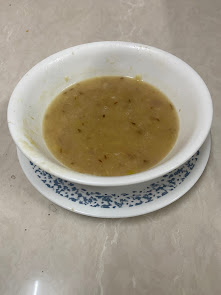Thiruvathirai Kali
Background
I have seen
Amma preparing Kali only once in a year. On the occasion of Thiruvathirai.
It looks
apparently simple, but needs lot of focus to get the right outcome. The most
important outcome is the texture, though flavour and colour are not far behind.
The process has to be enjoyed through all the five senses.
Ingredients
and Proportions
Good
quality white rice (not Basmati) – 1 cup
Jaggery – 1
cup
Moong Dal –
1 tbsp
Cardamom –
3 to 4 cloves
The
proportions are important. Rice and Jaggery should be equal. Water to Jaggery
is 2:1
Method
1) Wash the rice and rinse it
thoroughly
2) Roast the rice in a tava till it
becomes golden brown. Roast it on a low flame and enjoy the process. Keep
stirring to ensure uniform browning. Do bend your face once in a while to take
in the aroma of the roasting rice. It is fascinating to see the pearly white
grains take on golden hues. The grains shrivel up as they get heated, and if
you listen carefully you can hear a tinny sound as the rice beads collide
against one another. After all the white has disappeared, switch off the heat
and let it cool. Separately roast the Moong Dal and keep it aside.
3) Grind the roasted rice to a coarse
powder. This is a very critical step. Amma says the ground rice should feel
like rava. It took me less than 30 seconds in the mixer at the lowest speed.
Take care not to grind it fine.
4) Heat water in the tava and add all
the jaggery when it starts boiling. Stir vigorously to let the jaggery dissolve
and bring the syrup to boil.
5) When the jaggery syrup starts
bubbling, add the ground rice rapidly, while still stirring vigorously. Also add the roasted (not ground) Moong Dal. A
remarkable phase transformation takes place instantly. The powdered rice soaks up the syrup like a sponge, puffs
up and starts agglomerating. Switch off the flame. The final step shouldn’t
take more than 30 seconds.
6) Empty into a bowl and sprinkle
crushed cardamom. The Kali is ready to be eaten lukewarm. It may appear to be
lumpy, but if the lumps yield to the touch of your finger, than you have got it
right.
Kali can be enjoyed by itself, but it is customary to eat it vegetable
stew (puzhukku). I prepared the stew with flat beans (Avarakka), sweet potatoes
and raw banana. The traditional stew for Thiruvathirai is Avarakka and Kavathu
(purple yam).
Chemical Engineering Unit operations
Rinsing
Roasting
Grinding
Dissolution
Mixing
Agglomeration
Notes
1) Amma’s Kali is not as dark as mine,
most probably because I used organic jaggery. Amma uses rock jaggery (Katti Vellam)
2) The colour and flavour are largely driven by the choice of jaggery. But texture, the most important outcome, is a result of ratio, time and temperature.







How lovely... we call the veg side Thalagam and gramma says it should contain odd number of vegetables...
ReplyDelete